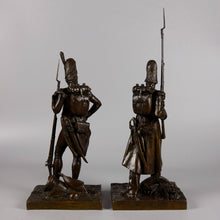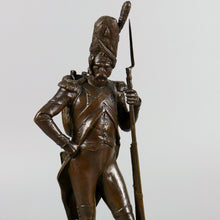A Pair of Bronze Grenadiers of Napoleon’s Imperial Guard
- Regular price
- £6,800
- Sale price
- £6,800
- Regular price
-
- Unit price
- /per
Adding product to your cart
Circa 1845
Highest point: 51cm (20in)
Patinated bronze. A pair of figures after Jean-Francois-Theodore Gechter.
The first, a Grenadier-à-Pied de la Garde Imperiale modelled in the 1815 campaign uniform of half-belted greatcoat and bearskin cap, bare of cords and plume, and equipped with the large Guard knapsack, musket and sabre-briquet of regimental pattern, advancing over battlefield debris comprising spent shot, a broken wheel and Prussian cap; the front of the naturalistic base inscribed ‘1814’. Height to bayonet point: 51cm (20in)
The second, modelled in full dress - tenue de grande parade - as usually donned before an action, to render the Old Guard as imposing a sight as possible, this comprising blue tail coat, fur cap with cords, white waistcoat, breeches, stock, gaiters, and blood red epaulettes, standing over a Russian mitre cap bearing the double headed eagle and an abandoned Russian field mortar; the front of the naturalistic base inscribed with date of Napoleon’s victory at Austerlitz ‘2 Decembre 1805’. Height of figures: 38cm (15in).
Read more
Napoleon’s Foot Grenadiers (1er Régiment de Grenadiers-à-Pied de la Garde Impériale) were one of the most venerated of regiments in the Grande Army, and termed the Old Guard. Whenever Napoleon went to war the Old Guard was present, serving from Madrid to Moscow as both his strategic campaign and battlefield reserve. Foot Grenadiers of the Imperial Guard were selected on physical traits, most notably above average height. They formed a formidable sight on the battlefield when mustered into regiments. The Guard enjoyed numerous privileges, including better pay, barracks and rations. They had their own hospital at Gros-Caillou near Paris. Line regiments not only had to give way the Old Guard on the line of march but to halt, present arms and sound a salute. Another privilege was the freedom to express discontent. Accordingly they were known as ‘les Grognards’ - the Grumblers. Some even did so in the presence of the Emperor. Such behaviour was unique to the Old Guard and would have been severely punished in any other unit.
Not all however were favourably impressed with their appearance. The British artist Benjamin Haydon, who saw them at Fontainbleau in 1814, noted ‘More dreadful looking fellows than Napoleon’s Guard I have never seen. They had the look of thoroughbred, veteran, disciplined banditti. Depravity, recklessness, and bloodthirstiness were burned into their faces ... Black moustachios, gigantic bearskins, and a ferocious expression were their characteristics.’ By the time of Waterloo these soldiers had an average age of thirty-five and were over 1.65 metres tall. All had twelve years service, four out of five had the Legion d’Honneur and a third had fought in over twenty campaigns.
Jean-Francois-Theodore Gechter (1796-1844) was a pupil, with Antoine-Louis Barye, of Fançois-Joseph Bosio and Antoine-Jean Gros (both ardent propagandists for Napoleon I). Under the influence of such dedicated servants of the First Empire and in keeping with Romanticisms’ yearning for past glories of the Napoleonic era, it is perhaps not entirely surprising that Gechter chose to celebrate France’s military glories in a series of bronzes depicting soldiers of the First Empire in both active and contemplative poses. Gechter received several important public commissions: a marble relief of the Battle of Austerlitz (1833–36) for the Arc de Triomphe; marble allegories of the Rhine and the Rhône for one of the fountains in the Place de la Concorde (1839); a St John Chrysostom (marble, 1840) for the Madeleine; and a marble statue of King Louis Philippe in coronation robes, commissioned in 1839.










